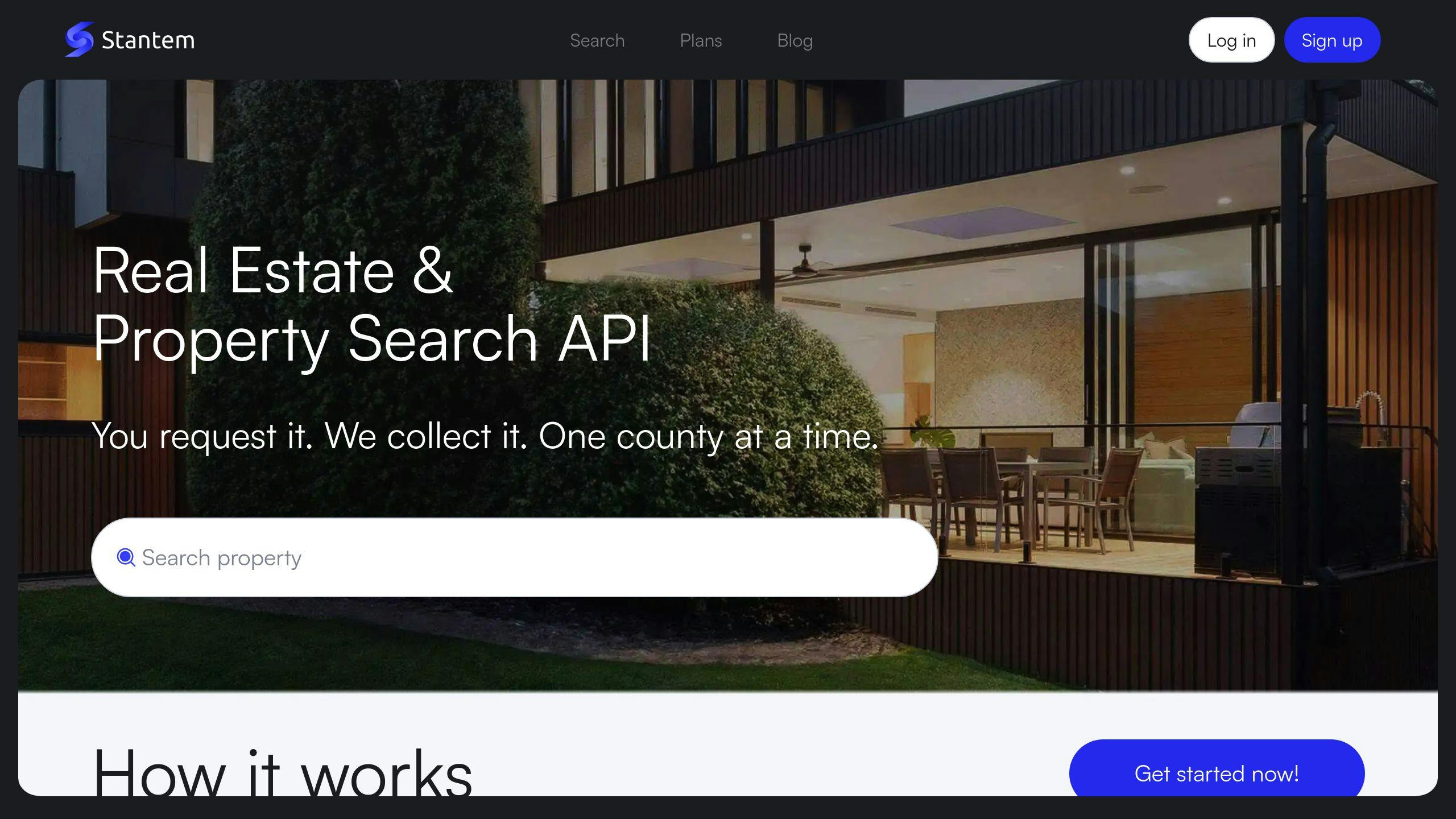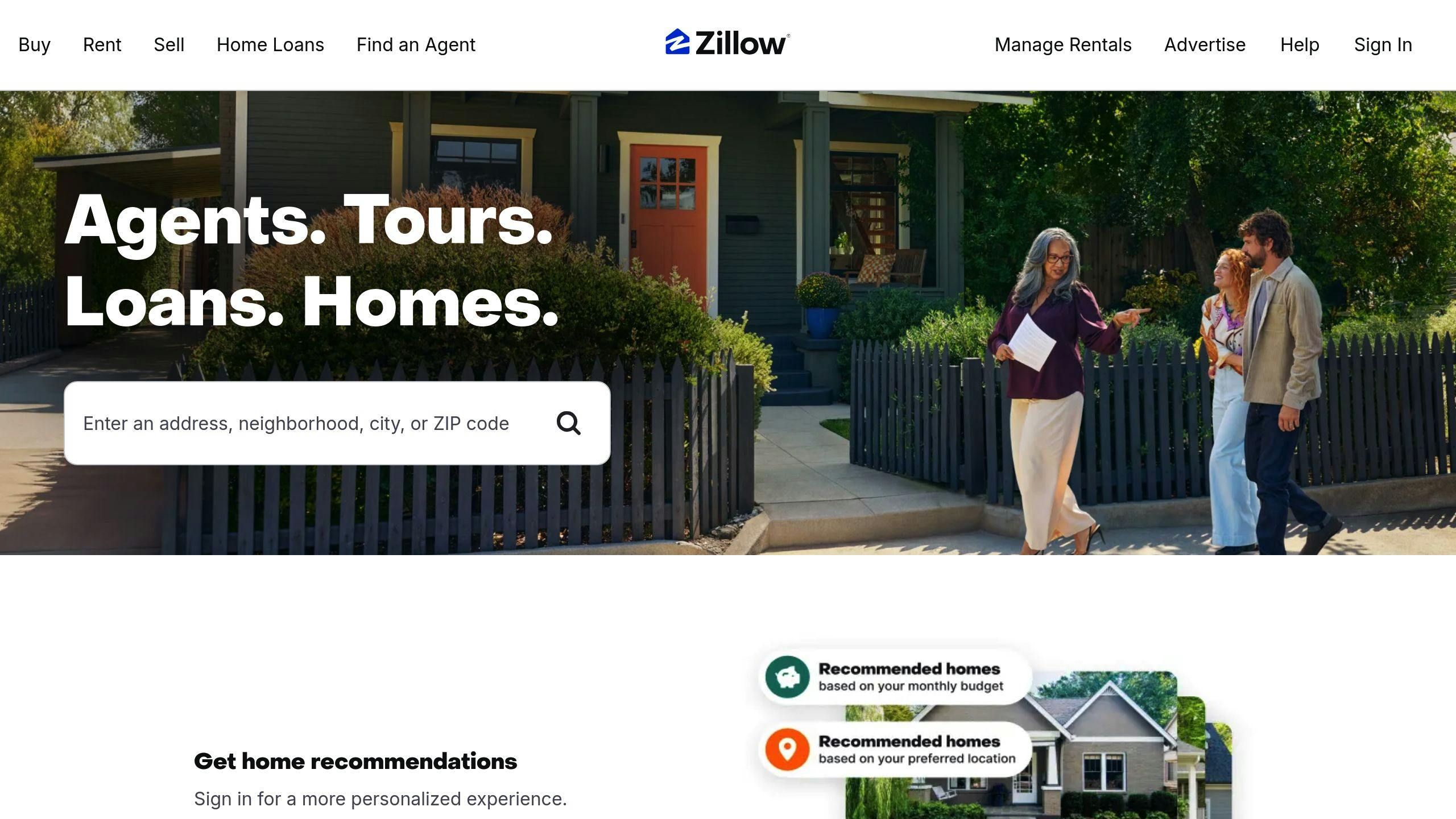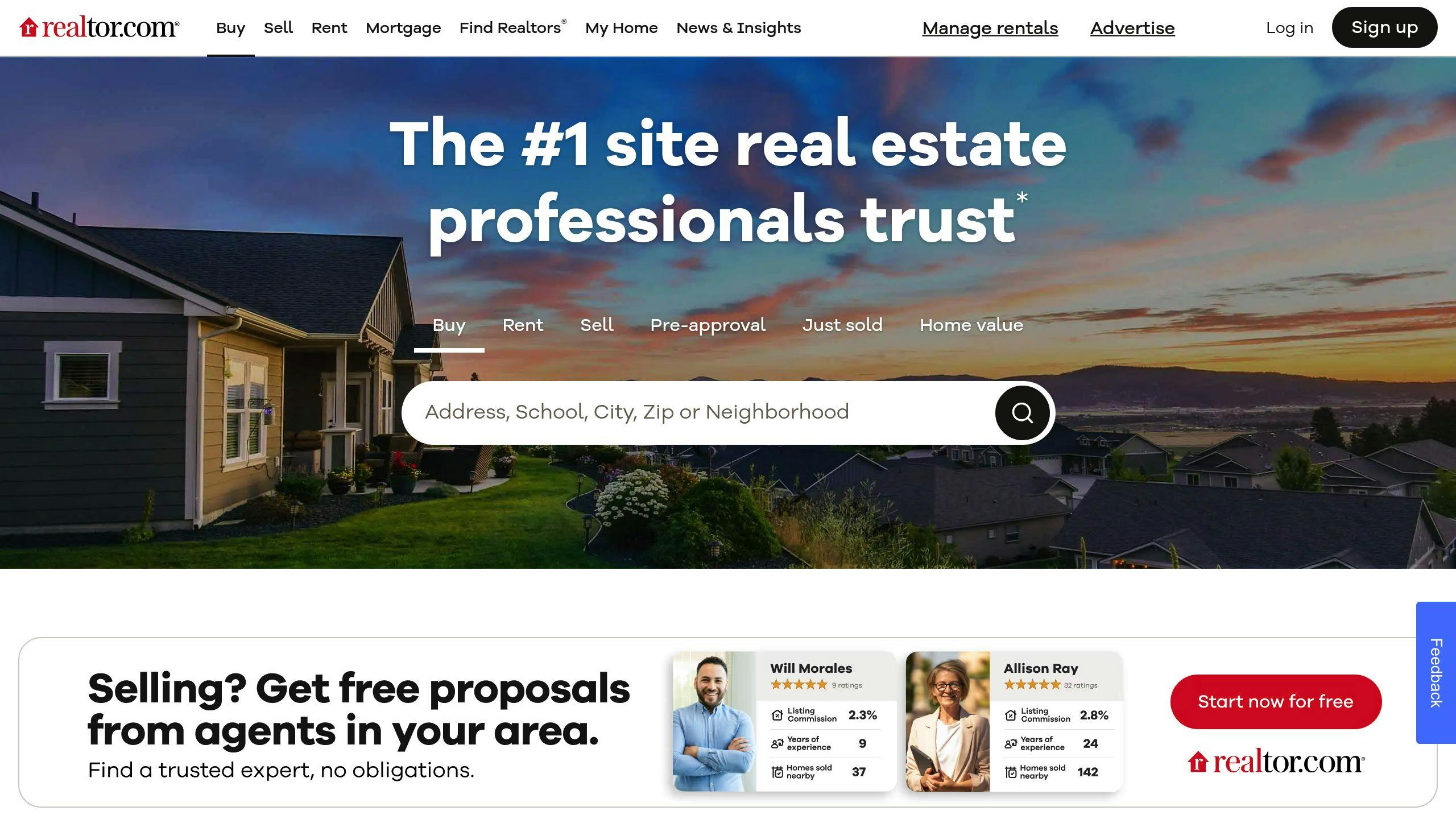If you're in real estate, choosing the right platform is key. Stantem, Zillow, and Realtor.com are the top options in 2024, each excelling in different areas. Here's a quick breakdown:
- Stantem: Best for developers and brokerages needing flexible APIs, bulk data exports, and advanced customization tools. Pricing starts at $120/month.
- Zillow: Ideal for consumer-focused agents, it offers an easy-to-use interface, broad property coverage, and free basic access, with premium tools for professionals.
- Realtor.com: Perfect for professionals prioritizing MLS access and lead generation, covering 99% of MLS listings with professional-grade tools.
Quick Comparison
| Platform | Strengths | Limitations | Best For |
|---|---|---|---|
| Stantem | Flexible APIs, bulk exports, detailed data | Steep learning curve, higher cost | Developers, large-scale data users |
| Zillow | User-friendly, broad coverage, free access | Limited data customization, pricey premium features | Consumer-focused agents |
| Realtor.com | Extensive MLS access, lead tools | Limited data export flexibility | Professionals needing MLS data |
Each platform serves unique needs, so consider your goals - whether it's data integration, consumer engagement, or MLS access - to pick the best fit for your business.
Related video from YouTube
1. Stantem Overview

Stantem is a property data platform built to meet the needs of real estate professionals in 2024. Here's a closer look at what it brings to the table.
Data Aggregation
Stantem automatically gathers property data from various sources using advanced tools. Its algorithms go through a detailed process to clean, enhance, and standardize the data, ensuring it stays accurate and up-to-date.
Technical Features and User Experience
The platform's API is designed to give developers and brokerages better access to property data. Key features include:
- Customizable data queries for tailored insights
- Integration with third-party platforms for smoother workflows
- Bulk data exports, making it easier to handle large datasets
The user interface focuses on practicality, offering intuitive dashboards. These dashboards provide a clear view of key property details such as geographic trends, market changes, price histories, and advanced search filters.
Pricing and Plans
Stantem offers three subscription levels:
- Standard: $120/month for smaller-scale needs
- Premium: $500/month for mid-sized businesses, with higher export limits
- Enterprise: Custom pricing for businesses needing nationwide or highly tailored data
These tiers cater to businesses looking for scalable and personalized solutions.
Security
Stantem prioritizes user data protection with encryption and compliance with regulations like GDPR and CCPA. Regular security audits are conducted to safeguard data.
While Stantem focuses on flexibility and customization, other platforms like Zillow take a more consumer-facing approach. We'll dive into that next.
2. Zillow Overview

Data Aggregation and Integration
Zillow pulls data from multiple sources using a mix of automated scraping and manual verification. It gathers property listings from MLS databases and its own datasets, ensuring a wide range of information [1][4]. By integrating MLS and IDX functionalities, Zillow keeps property data updated and synchronized, making it easier for real estate professionals to manage their workflows [5]. This setup allows professionals to access accurate property details through a single platform, reducing inconsistencies across sources.
User Experience
Zillow stands out for its user-friendly interface, catering to both everyday users and real estate professionals. The platform balances simplicity with detailed property data, offering insights like layouts, condition reports, nearby amenities, and neighborhood features [2]. Unlike Stantem, which focuses on professional data management, Zillow emphasizes accessibility for a broader audience.
Pricing and Plans
Zillow uses a tiered pricing system. General users can access the platform for free, while professionals can opt for premium tools. Enterprise users have the option for customized solutions. Although exact pricing isn't publicly available, this structure makes Zillow adaptable to both casual homebuyers and real estate experts.
Zillow's focus on consumer accessibility and seamless integration sets it apart, while Realtor.com takes a different route by leveraging its MLS partnerships for added benefits.
3. Realtor.com Overview

Data Aggregation and Integration
Realtor.com combines MLS databases with human input to create enriched and standardized property data, ensuring both accuracy and reliability. Its MLS and IDX integration offers a unified view of up-to-date property information, making it a go-to resource for real estate professionals.
User Experience
Realtor.com provides professional-grade tools and customizable reports that deliver insights tailored to the needs of real estate experts. Users can access detailed property information such as address, size, layout, condition reports, maintenance history, neighborhood features, and market data like inventory levels and price trends.
Pricing and Plans
The platform uses a tiered pricing model to cater to various user needs. Basic property searches are free, but premium features - like advanced market analytics and in-depth property insights - are available through paid subscriptions.
Performance and Market Position
Realtor.com holds the second spot in 2024 property search platform rankings due to its accurate data, user-friendly experience, and integration capabilities [1]. Its market analytics tools allow professionals to monitor key metrics, including inventory levels and pricing trends, helping them make informed decisions based on current market conditions [2].
This platform is a strong choice for professionals who need reliable data and actionable insights. While Zillow leads in consumer accessibility and Stantem specializes in professional data management, Realtor.com strikes a balance between comprehensive data integration and ease of use.
The next section will compare the strengths and weaknesses of these three platforms side by side.
Strengths and Weaknesses of Each Platform
Real estate search platforms come with their own set of perks and drawbacks. Here's a closer look at how three popular platforms stack up in areas that matter most to professionals in the industry.
| Platform | Strengths, Limitations & Features | Best Suited For |
|---|---|---|
| Stantem | • Offers flexible data integration and bulk export tools • Developer-friendly, allowing customizable analysis • Steeper learning curve for non-technical users • Higher cost for advanced features |
• Developers creating tailored real estate solutions • Brokerages needing in-depth data insights • Large-scale data operations |
| Zillow | • Connects with 3,000+ apps via Zapier • Broad MLS coverage and easy-to-use interface • Strong consumer brand recognition • Limited options for data customization and bulk exports • Premium features can be pricey |
• Agents focused on engaging with consumers • Professionals looking for basic integration tools • Those analyzing market trends |
| Realtor.com | • Covers 99% of MLS nationwide with over 1.5M active listings • Includes Lead Delivery API and email parsing tools • Limited flexibility in exporting data • Lacks advanced API features |
• Agents who need extensive MLS access • Professionals prioritizing lead generation • Specialists in market analysis |
Key Comparisons
Stantem shines in handling large-scale data projects and custom development, making it a go-to for enterprises. Zillow stands out with its seamless integration options through Zapier [3], while Realtor.com is a top choice for those seeking extensive MLS coverage and lead-generation tools. All three platforms emphasize data protection, employing robust validation and security measures [2].
Cost Structure
Stantem starts at $120/month, with pricing that scales for enterprise-level needs. Zillow and Realtor.com focus their pricing on premium features, which may be less accessible for smaller teams or organizations [1].
Up next, we'll break down how to choose the platform that best aligns with your professional goals and specific business needs.
Final Thoughts
After reviewing the top property search platforms for 2024, it's evident that each caters to specific needs within the real estate market. Picking the right one can streamline operations and improve how you handle data.
What Each Platform Brings to the Table
- Stantem: Known for its GraphQL API, it shines in data customization and bulk operations, making it a great choice for large-scale tasks that demand accurate data.
- Zillow: With a leading score of 102.2 [1], it sets the bar for consumer engagement and app integration, remaining the go-to platform for new home searches.
- Realtor.com: Scoring 98.3 [1], it stands out for its MLS coverage and strong lead generation tools, making it a favorite for real estate professionals.
Data Accuracy and Reliability
Stantem’s robust data verification and enrichment processes ensure professionals have access to dependable information, enabling smarter, data-driven decisions [4].
Key Factors to Weigh
- Integration Needs: For teams working with large datasets, Stantem’s developer-friendly tools are a standout.
- User Engagement: Zillow’s well-established ecosystem offers immediate benefits for those focused on capturing consumer attention.
- MLS Access: Realtor.com’s extensive coverage makes it a top choice for organizations needing broad MLS reach.
Choosing the wrong platform can lead to inefficiencies and missed opportunities. The goal is to find a solution that not only meets your current needs but also grows with your business. Below, we’ve addressed common questions to help you make the best decision.
FAQs
Is MLS or Zillow better?
MLS provides highly accurate, real-time updates directly from agents. Zillow, on the other hand, offers a wider range of properties, including For Sale By Owner (FSBO) listings, but its data can sometimes lag behind market changes.
| Feature | MLS | Zillow |
|---|---|---|
| Data Reliability | Real-time, highly accurate | Varies, may show outdated data |
| Data Source | Verified agent listings | Multiple sources, including users |
| Listing Coverage | Professional listings only | Broader, includes FSBOs |
Realtor.com, which integrates 99% of all MLSs, lists over 1.5 million active properties [3]. For those who need accurate, up-to-date information, MLS access through platforms like Realtor.com is often the better choice. However, Zillow remains a useful tool, especially for its large property database and user-friendly interface [1].
Key Points to Keep in Mind:
- MLS ensures real-time updates from verified agents.
- Zillow includes a broader variety of properties and historical data.
- MLS is ideal for professional transactions requiring precision.
- Zillow's extensive database is beneficial for consumer research.
Platforms like Realtor.com, which combine MLS data with advanced aggregation, are particularly useful for professionals who need reliable insights. By understanding the unique strengths of MLS and Zillow, users can choose the platform that best fits their needs, whether they prioritize accuracy or broader property options.
